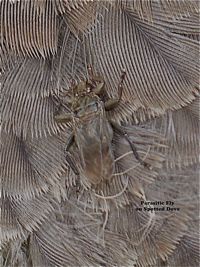Willi Kwek photographed a fly running around the body of the fledgling Spotted Dove (Streptopelia chinensis). “This fly, also seen on the other doves, appears to have special adaptations on its feet for holding onto feathers,” says Willi. “It also has a flat profile for easy burrowing through the feathers. It appears to irritate the dove, who would try to peck at it or to preen it off, but the fly is too quick. It darts all over the bird’s body, burrowing in and out, and it’s difficult to predict where or when it would next reappear on the surface. Thought your biology or ornithology friends might be interested. Took these photo with my kit lens so not so detailed.”
According to Dr Leong Tzi Ming, “The parasitic fly on the Spotted Dove is most likely to be the cosmopolitan Louse Fly, Pseudolynchia canariensis (Order Diptera: family Hippoboscidae: subfamily Ornithomyinae). It is a highly evolved, obligate ecto-parasite of birds, with a dorso-ventrally flattened body designed to slide in between feathers with ease. It also has robust limbs with strong claws, that aid in hanging on to a rapidly flying host. In Singapore, this parasitic fly has been recorded from Feral Pigeons (Columba livia), and is itself a vector for the hematozoan endoparasite, Haemoproteus columbae (Paperna & Smallridge, 2002). The Louse Fly has also been reported on many other avian hosts, including the Malayan Red Jungle Fowl (Gallus gallus spadiceus) (Lee & Amin-Babjee, 1993).
Image by Willi Kwek.
References:
1. Lee, C. C. & S. M. Amin-Babjee, 1993. New host records of parasites in the Malayan Red Jungle Fowl, Gallus gallus spadiceus. Pertanika J. Trop. Agric. Sci., 16(2): 107-110.
2. Paperna, I. & C. Smallridge, 2002. Haemoproteus columbae infection of feral pigeons in Singapore and Israel. Raffles Bull. Zool., 50(2): 281-286.










One Response